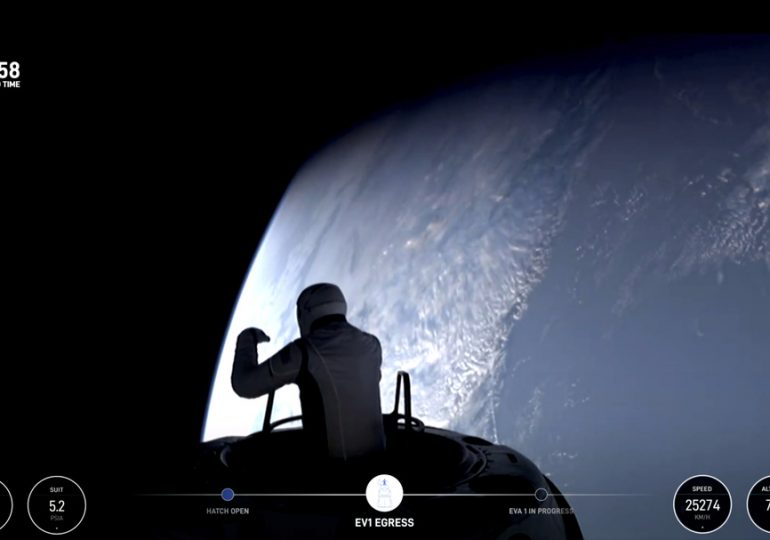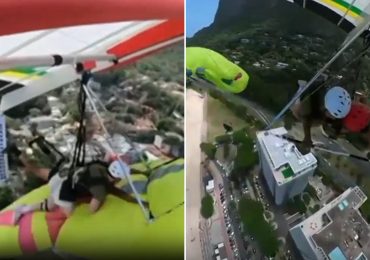Jared Isaacman and Sarah Gillis played it relatively safe when they floated outside of their Crew Dragon spacecraft just before 7:00 a.m. E.D.T. today, becoming the first nongovernmental astronauts to perform an extravehicular activity (EVA), better known as a spacewalk. But they knew the risk they were taking.
In 1965, the Soviet Union’s Alexei Leonov could barely fit back into his capsule due to an overinflated suit when he performed history’s first EVA. And American astronaut Gene Cernan almost lost his life during his Gemini 9 spacewalk the next year, when his helmet visor fogged over, his suit overheated, and he too had to fight to get back inside.
[time-brightcove not-tgx=”true”]
Isaacman and Gillis faced no such perils, partly due to the brief duration of their EVA and partly due to all that has been learned about spacewalking by the 263 other humans who have performed them since 1965. Instead, they marveled at the view and went about their principal task: testing SpaceX’s new, nimble spacesuits that the company hopes will be used on future missions to the moon and Mars.
“Congratulations @PolarisProgram and @SpaceX on the first commercial spacewalk in history!” NASA Administrator Bill Nelson posted on X. “Today’s success represents a giant leap forward for the commercial space industry and @NASA’s long-term goal to build a vibrant U.S. space economy.”
The EVA was just one of many jobs packed into the five-day Polaris Dawn mission. Other tasks include conducting medical studies, performing navigational maneuvers, and running a communications test with SpaceX’s Starlink satellite constellation. This week’s mission is the first of three flights in the Polaris series, all of which are being bankrolled by Isaacman, the billionaire founder and CEO of Shift4, an Internet payments company.
And the spacewalk wasn’t the only breakthrough for the mission. On Sept. 10, Polaris Dawn set a new altitude record for a crewed spacecraft in Earth orbit, soaring to 870 miles up, surpassing the altitude benchmark established by the Gemini 11 mission, in 1966. But it was the EVA that was the marquee event.
The entire exercise lasted one hour and 46 minutes, beginning with the depressurization of the spacecraft and the opening of the hatch. The International Space Station (ISS) is equipped with an airlock, meaning that the outpost remains pressurized when astronauts venture outside, allowing the ones who remain behind to continue working in shirtsleeves. The Dragon, however, has no such airlock. That required the other two astronauts, Scott Poteet and Anna Menon, who stayed inside the spacecraft, to be suited as well, since the cockpit, like the environment outside, would become a vacuum.
To prepare the crew for this pressure change, shortly after the mission’s Sept. 10 liftoff, ground controllers slowly started increasing the oxygen ratio in the oxygen-nitrogen capsule atmosphere while simultaneously lowering the pressure from the earthly 14.7 pounds per square inch to just five pounds—the pressure inside the suits. These adjustments prevent the occurrence of the bends—painful and dangerous nitrogen bubbles, which form in the bloodstream and tissues of the astronauts.
With the astronauts’ bodies prepped and the cabin vented, Isaacman opened the wide hatch in the nose of the spacecraft at 6:12 a.m. E.D.T. and floated outside at 6:51 a.m. E.D.T. ISS astronauts wear portable life support system (PLSS) backpacks, since they have to make their way to often remote spots on the station, which is larger than a football field. Isaacman and Gillis had no PLSS, instead getting their oxygen and power via 12-foot umbilical cords, which also prevented them from accidentally drifting off into space.
They could get away with only those tethers since they didn’t venture far—standing just outside the hatch, while holding onto a railing resembling a mobility support system, that SpaceX dubbed the Skywalker. Early astronauts routinely practiced such so-called stand-up EVAs. Buzz Aldrin, the second man on the moon, performed two during the 1966 flight of Gemini 12. Astronaut Dick Gordon, of Gemini 11, famously fell asleep during a stand-up EVA as he was climbing back into his hatch, after exhausting himself free-floating and maneuvering outside the spacecraft.
Isaacman and Gillis had no opportunity for a nap. Each was outside for no more than 10 minutes, and spent most of their time flexing, reaching, and bending in their suits, testing their mobility and comfort. SpaceX envisions mass-producing the suits one day—in pursuit of its long-term goal of colonizing Mars—and this first flight test was a key step.
“It’ll look like we’re doing a little bit of a dance,” Isaacman said in an August press conference at NASA’s Kennedy Space Center. “The idea is to learn as much as we possibly can about this suit and get it back to the engineers to inform future suit design evolutions.”
At the end of the EVA, Kate Tice, the SpaceX mission commentator, said that the entire experience went by “in the blink of an eye,” and indeed it must have seemed that way—especially compared to the seven hours ISS astronauts may spend outside. The 20 minutes total that Isaacman and Gillis logged nearly matched the 23-minute EVA of NASA astronaut Ed White, who made the first American spacewalk during the 1965 mission of Gemini 4. White had to be coaxed back inside, playfully telling both Houston and his commander, astronaut Jim McDivitt, that he refused to bring the adventure to an end. Finally, he agreed, making his way back to his hatch and saying, “It’s the saddest moment of my life.”
Isaacman, from his perch above the planet, likely felt the same. “Back at home we have a lot of work to do,” he said, as he looked down on the South Pacific from an altitude of 458 miles, “but from here, it sure looks like a perfect world.”
Leave a comment








